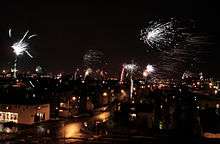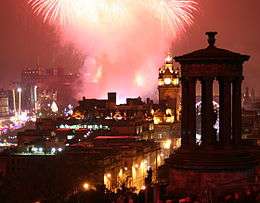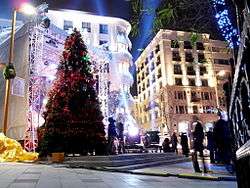New Year's Eve
| New Year's Eve | |
|---|---|
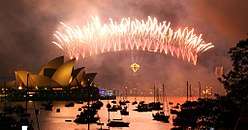 Sydney, Australia is one of the first major world cities to ring in the New Year and its televised fireworks displays are watched by millions. | |
| Also called |
|
| Observed by | People around the world |
| Type | International |
| Significance | The final day of the Gregorian year |
| Celebrations | Reflection; late-night partying; family gatherings; feasting; gift exchanges; fireworks; countdowns; watchnight services; social gatherings, during which participants may dance, eat, consume alcoholic beverages, and watch or light fireworks |
| Date | 31 December |
| Next time | 31 December 2018 |
| Frequency | Annual |
| Related to | New Year's Day |
In the Gregorian calendar, New Year's Eve (also known as Old Year's Day or Saint Sylvester's Day in many countries), the last day of the year, is on 31 December which is the seventh day of Christmastide. In many countries, New Year's Eve is celebrated at evening social gatherings, where many people dance, eat, drink alcoholic beverages, and watch or light fireworks to mark the new year. Some Christians attend a watchnight service. The celebrations generally go on past midnight into New Year's Day, 1 January.
Samoa, Tonga and Kiritimati (Christmas Island), part of Kiribati, are the first places to welcome the New Year while American Samoa and Baker Island in the United States of America are among the last.[1]
Africa
Algeria
In Algeria, New Year's Eve (French: Réveillon; Arabic: Ra’s al-‘Ām) is usually celebrated with family and friends. In the largest cities, such as Algiers, Constantine, Annaba, Oran, Sétif and Béjaïa, there are large celebrations which may feature concerts, late-night partiying, firecrackers, fireworks at midnight and sparklers and shouts of "Bonne année !".
The Martyrs' Memorial and the Grand-Post Place in Algiers are the main attraction for the majority of Algerians during the celebration; while some others prefer spending this special night outside the country, generally in Tunis or Paris.
At 8pm (AST), the President's message of greetings to Algerians is read on TV. EPTV network airs a yearly New Year's Eve entertainment show, variying its name, hosts and guests, which features sketches and musical performances. Popular films are also broadcast.
At home or at restaurants, a special type of pastry cake, called "la bûche" is eaten, and black coffee or soda is drunk with it, few minutes before the New Year's countdown.
On New Year's Day (le jour de l'an), people, especially children, write their "New Year's letter" on decorated paper, called "Carte de bonne année", to their parents and relatives, featuring their resolutions and wishes.
Egypt
In Egypt the new year is celebrated with fireworks, fire crackers, smashing glass bottles or breaking things on the street also.
Ghana
In Ghana, many people celebrate New Year's Eve by going to Church; others go to nightclubs, pubs, or take to the street to celebrate. At midnight, fireworks are displayed across various cities of Ghana, especially in Accra and Tema.
Morocco
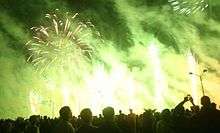
In Morocco, New Year's Eve (Arabic: رأس العام, translit. Rass l'aam—"head of the year") is celebrated in the company of family and friends. People get together to eat cake, dance, and laugh. Traditionally, people celebrate it at home, but some prefer to go to nightclubs. At midnight, fireworks are displayed across Ain Diab, in the corniche of Casablanca.
Nigeria

In Nigeria, the New Year's Eve is often celebrated by going to Church; others go to nightclubs, and parties organised by individuals, communities or State government like the Lagos Countdown. The Lagos Countdown is an event in Nigeria, created to increase tourism and making Lagos a premium destination for business and leisure. The event kicks off in December and lasts till 1 January. It is attended by an average of 100,000 people. The event takes place at the Eko Atlantic city, beside the Barbeach attracting thousands of domestic and foreign tourists who are entertained every evening by different artists...
South Sudan
In South Sudan, people attend church services at many churches in Juba. The service begins at 9PM. At the stroke of midnight, people sing the famous carol, Hark! The Herald Angels Sing to mark the end and beginning of the year with a blessing. The service ends at 12:30AM.
Americas
Argentina
Traditional celebrations in Argentina include a family dinner of traditional dishes, including vitel tonné, asado, sandwiches de miga, piononos. Like dessert: turrón, mantecol and pan dulce.[2]
Just before midnight, people flock to the streets to enjoy fireworks and light firecrackers. The fireworks can be seen in any terrace. The first day of the New Year is celebrated at midnight with cider or champagne. People wish each other a happy New Year, and sometimes share a toast with neighbours. Parties often continue until dawn.
The celebration is during the summer, like in many South American countries, so it's normal to see many families in the New Year at tourist centers of the Argentine Atlantic coast (Mar del Plata, Necochea, Villa Gesell, Miramar, etc.).[3]
Brazil
.jpg)
The New Year (Portuguese: Ano Novo), is one of Brazil's main holidays. It officially marks the beginning of the summer holidays, which last until Carnival. Brazilians traditionally have a copious meal with family or friends at home, in restaurants or private clubs, and consume alcoholic beverages. Champagne is traditionally drunk. Those spending New Year's Eve at the beach usually dress in white, to bring good luck into the new year. Fireworks and eating grapes or lentils are customs associated with the holiday.
The beach at Copacabana in Rio de Janeiro is ranked among the top 10 New Year Fireworks display. The combination of live concerts, a spectacular fireworks display and millions of revelers combine to make the Copacabana's New Year's party one of the best in the world. In addition, the celebrations are broadcast on TV, the most famous being the Adues A Tudo Isso on Rede Globo.
In other regions, different events also take place. The most famous are on the edge of coastal cities, such as Copacabana. In the Northeast, in Fortaleza, the party is in Iracema Beach, and in Salvador, the change of year happens in a great music festival. In the South, the most famous festivities on the coast take place in Santa Catarina: on the Beira-mar Norte Avenue, in Florianópolis, and in the Central Beach of Balneário Camboriú. Other celebrations that stand out even from the sea are those of Manaus, in the northern state of Amazonas, and the Paulista Avenue, in São Paulo, the largest city in the country, and Ministries Esplanade, in the capital Brasília. The party attracts more than one million people. It features fireworks and live music shows.[4][5][6][7][8][9][10]
The city of São Paulo hosts the Saint Silvester Marathon (Corrida de São Silvestre) which traverses streets between Paulista Avenue and the downtown area.[11]
Canada
New Year traditions and celebrations in Canada vary regionally. New Year's Eve (also called New Year's Eve Day or Veille du Jour de l'An in French) is generally a social holiday. In many cities, such as Toronto, Ottawa and Niagara Falls in Ontario, Edmonton and Calgary in Alberta, Vancouver, British Columbia and Montreal, Quebec, there are large celebrations which may feature concerts, late-night partying, sporting events, and fireworks, with free public transit service during peak party times in most major cities. In some areas, such as in rural Quebec, people ice fish in the old days. Since 2000, the highlight of New Year's Eve celebrations is in Montreal's old port, which comes alive with concerts that take place and fireworks at midnight.[12]
From 1956 to 1976, Guy Lombardo and his Royal Canadians serenaded Canada on the CBC, via a feed from CBS, from the ballroom of the Waldorf-Astoria Hotel on Park Avenue in New York City. After Lombardo's death in 1977, the Royal Canadians continued on CBC and CBS until 1978.
In 1992, the sketch comedy troupe Royal Canadian Air Farce began airing its annual New Year's Eve special Year of the Farce on CBC Television, which features sketches lampooning the major events and news stories of the year. The 1992 edition was presented as a one-off special, but served as a pilot for a regular Air Farce series that premiered the following year, and ran until 2008. Year of the Farce episodes continued to air annually as part of the series, while the 2008 edition doubled as the program's series finale. One-off Year of the Farce specials have continued to air on New Year's Eve or New Year's Day since, featuring members of the original cast.[13][14]
Similarly, the CBC's French language network Ici Radio-Canada Télé airs its own yearly New Year's Eve comedy special, Bye Bye. Unlike Year of the Farce, Bye Bye has been presented by various comedians; originally running from 1968 to 1998, it was revived in 2006 by the Québécois troupe Rock et Belles Oreilles. Its 2008 edition, hosted and co-produced by Québécois television personality Véronique Cloutier, was criticized for featuring sketches that viewers perceived as offensive, including sketches making fun of English Canadians and then American president-elect Barack Obama.[15]
Chile
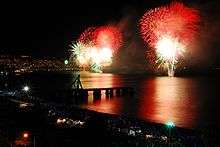
New Year's Eve is celebrated in Chile by the observation of traditional rituals, such as wearing yellow underwear and yellow clothing. It is said to restore vitality to your life. People who want to travel walk the streets with a suitcase in hand, others hold money in their hand or place coins at their door for good fortune in the new year. Celebrations include a family dinner with special dishes, usually lentils for good luck, and twelve grapes to symbolize wishes for each month of the coming year.[16] Family celebrations usually last until midnight, then some continue partying with friends until dawn. In Chile's capital Santiago, thousands of people gather at the Entel Tower to watch the countdown to midnight and a fireworks display.
There are several fireworks shows across the country. Over one million spectators attend the most popular, the "Año Nuevo en el Mar", in Valparaiso.[17] Since 2000, the sale of fireworks to individuals has been illegal,[18] meaning fireworks can now only be observed at major displays.
Many people also travel to Easter Island, off Chile's coast, to welcome the New Year.
Colombia
In Colombia it is a traditional celebration. There are many traditions across the country. Included among these traditions are: a family dinner with special dishes, fireworks, popular music, wearing special or new clothes, eating empanadas and different parties. With each stroke of the clock until midnight, the families eat grapes.
Costa Rica
In Costa Rica, families usually gather around 8 pm for parties that last until 1 or 2 am, the next day. There are several traditions among Costa Rican families, including eating 12 grapes representing 12 wishes for the new year, and running across the street with luggage to bring new trips and adventures in the upcoming year.
El Salvador
In El Salvador, New Year's Eve is spent with families. Family parties start around 5:00 pm, and last until 1:00 to 3:00 am, the following day. Families eat dinner together and sing traditional New Year's Eve songs, such as "Cinco para las Doce". After the dinner, individuals light fireworks and continue partying outside. A radio station broadcasts a countdown to midnight. When the clock strikes midnight, fireworks are lit across the country. People start exchanging hugs and wishes for the new year.
Ecuador
A New Year's Eve tradition in Ecuador is for men to dress haphazardly in drag (clowny looking make-up, cheap colorful wigs, very hairy legs in miniskirts) for New Year's Eve representing the "widow" of the year that has passed. The "widows" then go to the streets and stop each car that passes on that particular street in order to parody some form of sexy dancing. Large crowds would gather around to watch and laugh at the entertainment and the drivers are forced to give the "widows" some coins in order to obtain passage through the street.
There are also traditional family events and meals and modern celebrations such as hosting parties and going to nightclubs. People usually eat grapes and drink Champagne with close family members and friends.
The main event takes place at midnight where fireworks are lit along with thousands of life-size effigies called "Año Viejo". Most every local family creates the effigy from paper scraps, old clothes or purchases it altogether. They place just outside the front of their home. The effigy represents things you disliked from the previous year and are made to look like famous celebrities, politicians, public servants, cartoons, etc. They are burnt right at midnight to shed the old year and represent a new beginning. Some of the braver Ecuadorians jump through these burning effigies 12 times to represent a wish for every month.
Guatemala
In Guatemala, banks close on New Year's Eve, and businesses close at noon.[19] In the town of Antigua, people usually gather at the Santa Catalina Clock Arch to celebrate New Year's Eve (Spanish: Fin del Año). In Guatemala City the celebrations are centered on Plaza Mayor. Firecrackers are lit starting at sundown, continuing without interruption into the night. Guatemalans wear new clothes for good fortune and eat a grape with each of the twelve chimes of the bell during the New Year countdown, while making a wish with each one.
The celebrations include religious themes which may be either Mayan or Catholic.[20] Catholic celebrations are similar to those at Christmas. Gifts are left under the tree on Christmas morning by the Christ Child for the children, but parents and adults do not exchange gifts until New Year's Day.[21]
Mexico
Mexicans celebrate New Year's Eve, (Spanish: Vispera de Año Nuevo) by eating a grape with each of the twelve chimes of a clock's bell during the midnight countdown, while making a wish with each one. Mexican families decorate homes and parties in colors that represent wishes for the upcoming year: red encourages an overall improvement of lifestyle and love, yellow encourages blessings of improved employment conditions, green for improved financial circumstances, and white for improved health. Mexican sweet bread is baked with a coin or charm hidden in the dough. When the bread is served, the recipient of the slice with the coin or charm is said to be blessed with good luck in the New Year. Another tradition is to make a list of all the bad or unhappy events over the past 12 months; before midnight, this list is thrown into a fire, symbolizing the removal of negative energy from the new year.[22] At the same time, they are expressed for all the good things during the year that is ending so that they will continue in the new year.[23]
Mexicans celebrate with a late-night dinner with their families, the traditional meal being turkey or pork loin. Afterwards many people attend parties outside the home, for example, in night clubs. In Mexico City there is a street festival on New Year's Eve centered on the Zocalo, the city's main square.[24] Celebrations include firecrackers, fireworks and sparklers and shouts of "¡Feliz Año Nuevo!"
Puerto Rico
In Puerto Rico, New Year's Eve is celebrated with friends and family. The Puerto Rico Convention Center in San Juan is the main attraction for Puerto Ricans during the celebration. It has Latin music and fireworks at midnight along with the signature song "Auld Lang Syne" in Spanish.
Suriname
During New Year's Eve in Suriname, the Surinamese population goes into cities' commercial districts to watch fireworks shows. This is a spectacle based on the famous red-firecracker-ribbons. The bigger stores invest in these firecrackers and display them in the streets. Every year the length of them is compared, and high praises are held for the company that has managed to import the largest ribbon. These celebrations start at 10 am and finish the next day. The day is usually filled with laughter, dance, music, and drinking. When the night starts, the big street parties are already at full capacity. The most popular fiesta is the one that is held at café 't Vat in the main tourist district. The parties there stop between 10 and 11 pm after which the people go home to light their pagaras (red-firecracker-ribbons) at midnight. After midnight, the parties continue and the streets fill again until daybreak.
Trinidad
In Port of Spain the tradition is to celebrate in one's yard with friends, family and neighbors, and eat and drink till sunrise. At midnight the city becomes festive with fireworks in every direction. The celebration only starts at midnight. Music is heard from all the houses and bars, nightclubs, street parties, Soca raves. The people are celebrating not only the new year but the beginning of the carnival season as well.
United States

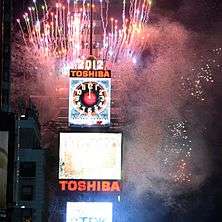
In the United States, New Year's Eve is celebrated with formal parties and concerts, family-oriented activities, and large public events such as firework shows and "drops".
The most prominent celebration in the country is the "ball drop" held in New York City's Times Square. Inspired by the time balls that were formerly used as a time signal, at 11:59 p.m. ET, an 11,875-pound (5,386 kg), 12-foot-diameter (3.7 m) ball covered in panels made of Waterford crystal, is lowered down a 70 feet (21 m) high pole on the roof of One Times Square, reaching the roof of the building 60 seconds later at midnight. The event has been held since 1907, and has seen an average attendance of 1,000,000 yearly.[25] The popularity of the spectacle has inspired similar events outside of New York City, where objects that represent a region's culture, geography, or history are raised or lowered in a similar fashion—such as Atlanta's Peach Drop, representing Georgia's identity as the "Peach State", and Brasstown, North Carolina's lowering of a live opossum in a glass enclosure (an event which has historically attracted criticism from animal rights groups).[26][27]
Radio and television broadcasts of festivities from New York City helped to ingrain them in American pop culture; beginning on the radio in 1928, and on CBS television from 1956 to 1976 with ball drop coverage, Guy Lombardo and his band, The Royal Canadians, presented an annual New Year's Eve broadcast from the ballroom of New York's Waldorf-Astoria Hotel. The specials were best known for the Royal Canadians' signature performance of "Auld Lang Syne" at midnight, which made the standard synonymous with the holiday.[28][29] Following Lombardo's death in 1977, the competing program New Year's Rockin' Eve (which premiered for 1973 on NBC before moving to its current home, ABC, for 1975), succeeded the Royal Canadians as the most-watched New Year's Eve special on U.S. television. Its creator and host, Dick Clark, intended the program to be a modern and youthful alternative to Lombardo's big band music, by showcasing performances by popular musicians as part of the broadcast. Including ABC's special coverage of the year 2000, Clark would host New Year's Eve coverage on ABC for 33 straight years. After suffering a stroke in December 2004 (resulting in Regis Philbin guest hosting for 2005), Clark retired as full-time host of the special for the 2006 edition, and was succeeded by Ryan Seacrest. Clark continued to make limited appearances on the special until his death in 2012.[30][31][32][33][34]
Other notable celebrations include those on the Las Vegas Strip, where streets are closed to vehicle traffic on the evening of New Year's Eve, and a fireworks show is held at midnight which spans across multiple buildings on the Strip.[35] Los Angeles, a city long without a major public New Year celebration, held an inaugural gathering in Downtown's newly completed Grand Park to celebrate the beginning of 2014. The event included food trucks, art installations, and culminating with a projection mapping show on the side of Los Angeles City Hall near midnight. The inaugural event drew over 25,000 spectators and participants.[36] For 2016, Chicago introduced an event known as Chi-Town Rising.[37] Alongside the festivities in Times Square, New York's Central Park hosts a "Midnight Run" event organized by the New York Road Runners, which culminates in a fireworks show and a footrace around the park that begins at midnight.[35] Major theme parks also hold New Year's celebrations; Disney theme parks, such as Walt Disney World Resort in Florida and Disneyland in Anaheim, California, are traditionally the busiest around the Christmas and New Year's holidays.[35][38][39]
Religious observances
In the Roman Catholic Church, 1 January is a solemnity honoring the Blessed Virgin Mary, the Mother of Jesus; it is a Holy Day of Obligation in most countries (Australia being a notable exception), thus the Church requires the attendance of all Catholics in such countries for Mass that day. However a vigil Mass may be held on the evening before a Holy Day; thus it has become customary to celebrate Mass on the evening of New Year's Eve. (New Year's Eve is a feast day honoring Pope Sylvester I in the Roman Catholic calendar, but it is not widely recognized in the United States.)
Many Christian congregations have New Year's Eve watchnight services. Some, especially Lutherans and Methodists and those in the African American community, have a tradition known as "Watch Night", in which the faithful congregate in services continuing past midnight, giving thanks for the blessings of the outgoing year and praying for divine favor during the upcoming year. In the English-speaking world, Watch Night can be traced back to John Wesley, the founder of Methodism,[40] who learned the custom from the Moravian Brethren who came to England in the 1730s. Moravian congregations still observe the Watch Night service on New Year's Eve. Watch Night took on special significance to African Americans on New Year's Eve 1862, as slaves anticipated the arrival of 1 January 1863, when Lincoln had announced he would sign the Emancipation Proclamation.[41]
Venezuela
Radio specials give a countdown and announce the New Year. In Caracas, the bells of the Cathedral of Caracas ring twelve times.[42] During these special programs, is a tradition to broadcast songs about the end of the year. It is a non-working holiday. Popular songs include "Viejo año" ("Old year"), by Gaita group Maracaibo 15, and "Cinco pa' las 12" ("Five minutes before twelve"), which was versioned by several popular singers including Nestor Zavarce, Nancy Ramos and José Luis Rodríguez El Puma. The unofficial hymn for the first minutes of the New Year is "Año Nuevo, Vida Nueva" ("New Year, New Life"), by the band Billo's Caracas Boys. Many people play the national anthem in their houses.
Traditions include wearing yellow underwear, eating Pan de jamón, and 12 grapes with sparkling wine.
Special holiday programs are broadcast on Venezuelan television stations including Venevision.
Asia
Bangladesh
The New Year celebrations take place in all around the country mostly in Dhaka, Chittagong, Sylhet, Rajshahi, Khulna, Barishal, Cox's Bazar etc. The celebrations mostly take place at night. On this day, people go to the parties at club or hotels, beaches, at the crowdy roadsides and bridges where firecrackers are blast out in the sky at night. The roadsides and bridges are also lighted up by colourful lights at night. People do a get-together as well as enjoy with their families. That day, Cox's Bazar becomes a popular tourist destination for both Bangladeshi and foreign tourists.
Music, songs and dances are organized in the auditoriums, hotels, beaches and as well as in the grounds which are shown live concert on T.V where many Dhallywood celebrities along with many personalities participate in the dance, music, songs and often drama to liven up the concert more. Sometimes marriages and weddings take place in the clubs at night of 31 December so that the people can enjoy more.[43] People also enjoy the New Year's Eve with their families, relatives and friends in the ships and yachts specially in the sea while going to Saint Martin where DJs liven up their night through their music and songs.[44]
The Muslims during the year's last Jumma prayer of mosque permanently pray a Munajat(which is done all over the mosques of the country) so that Allah may bless them and the coming year can be fruitful.[45] Hindus organize a Puja so that the coming year can be fruitful for them. The Christians go to the churches for a watch night service till midnight, praying for blessing in the coming new year as it is also part of the Christmastide season observances.
China
In China, although the celebrations of the Lunar New Year are not until a few weeks after the Gregorian New Year, celebrations of the Gregorian New Year are held in some areas, particularly in major cities. For example, celebrations with fireworks and rock concerts have taken place in Beijing's Solana Blue Harbor Shopping Park, while cultural shows and other events are held at the city's Millennium Monument, Temple of Heaven, Great Wall of China, Olympic Green, and the Summer Palace. Since 2011, a light and sound show has been held at The Bund in Shanghai, a few minutes before midnight.
Hong Kong
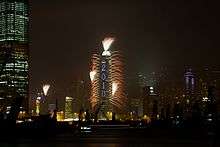
In Hong Kong, many gather in shopping districts like Central, Causeway Bay and Tsim Sha Tsui. Beginning in 2008, a 60-second numerical countdown to New Year's, consisting of LED lights and pyrotechnic display effects, on the facade of Two International Finance Centre was launched, followed by a firework display, alongside an exhibition of the Symphony of Lights. For the arrival of 2013, the Hong Kong Convention and Exhibition Centre initiated the countdown, while the fireworks display and A Symphony of Lights show were extended to eight minutes.
Shopping malls are often major celebration venues. The Times Square shopping mall, for instance, holds their own celebration of the ball drop held at Times Square, New York City. There are also various district-wide celebrations.
Central Asia
In Central Asia, New Year's Eve celebrations were inherited from Soviet traditions; thus they are similar to those of Russia. An example of such traditions would be the playing of the national anthem at midnight and the presidential address before it.
India
Most celebrations take place in the major metropolitan cities like Kochi, Delhi, Mumbai, Kolkata, Chennai, Chandigarh, Hyderabad, Bangalore, Pune, Ahmedabad. New Year is also celebrated in other cities and towns around the country like Agra, Bhubaneswar, Coimbatore, Cuttack, Vadodara, etc., There are lots of shows, events, awards and parties organized all over India. Big and small celebrities and personalities perform as well as enjoy in these parties. Many Discos and Pubs organize big singers, DJs or local talent to liven up the night with their music and songs. Goa and Kerala are the most visited destination during New Year's celebration both by Indian and foreign tourists.
Major events like live concerts and dances by Bollywood stars are also organized and attended mostly by youngsters. More often people like to celebrate the New Year Eve with their family. Hotels and resorts are also decked up in anticipation of tourist arrival and intense competition makes them entice the tourists with exciting New Year offers. Many people across the country also follow old traditions. The Hindu community organize Pujas for a fruitful year ahead and the Christian community often go to church for a watch night service till midnight praying for blessing in the coming new year.
Indonesia
New Year's Eve celebrations in Medan (capital of North Sumatra) first Dunia Terbalik New Year Countdown Celebrations fireworks in Indonesia was part of the Fiesta Black Tea, named "Medan Pelita Harapan University down eve countdown." Apart from the Lippo Plaza Medan, the tallest building in Lippo Malls at the time on both sides of the CIMB Niaga Plaza. The event, which celebrated the arrival of 2018, attracted 400,000 spectators along both sides of the CIMB Niaga. The countdown was televised live coverage in Indonesia via digital high-definition on satellite transmission aired on RCTI HD's Dunia Terbalik and main sponsor by Fiesta Black Tea inviting various national performances such as Dunia Terbalik All Star along with Dunia Terbalik, reaching more than 1.9 million television audiences. Over 200 local and overseas media covered the spectacular that generated publicity value of more than RP1000 million was six officially opening ceremony to grand opening by Father of Albert Effendy Darmawan Effendy, Medan Pelita Harapan University Angelia Chairiana, Medan Pelita Harapan University Viona Valencia, President of the Republic of Indonesia Joko Widodo, CEO of MNC Group Hary Tanoesoedibjo and Governor of Jakarta Anies Baswedan in time for regional celebrated its first years of anniversary alongside fireworks, Mayor Dzulmi Eldin lit an "eternal flame".
Japan
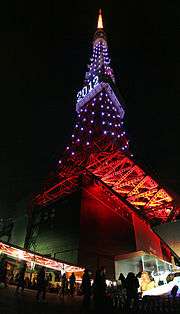
In Japan, New Year's Eve is used to prepare for and welcome Toshigami (年神), the New Year's god. People clean their home and prepare Kadomatsu or Shimenawa to welcome the god before New Year's Eve. Buddhist temples ring their bells 108 times[46] at midnight in the tradition Joya no Kane (除夜の鐘). The rings represent the 108 elements of bonō (煩悩), mental states that lead people to take unwholesome actions.
In most cities and urban areas across Japan, New Year's Eve celebrations are usually accompanied by concerts, countdowns, fireworks and other events. In Tokyo, the two most crowded celebrations are held at the Shibuya crossing in Shibuya and the Zojoji Temple in Minato. People gather around the Zojoji Temple to release helium balloons with New Year's wishes up in the sky and watch the lighting of Tokyo Tower and Tokyo Skytree with a year number displayed on the observatory at the stroke of midnight.
Three notable music-oriented television specials air near New Year's Eve. Since 1951, NHK has traditionally broadcast Kōhaku Uta Gassen (Red and White Song Battle) on New Year's Eve, a music competition where two teams of popular musicians (the red and white teams, which predominantly contain female and male performers respectively) perform songs, with the winning team determined by a panel of judges and viewer votes. The special is traditionally one of the most-watched television programs of the year in Japan. Although it did air on 31 December from 1959 to 2006, the Japan Record Awards ceremony, recognizing outstanding achievements in the Japanese music industry, is held annually on 30 December since 2007 and is broadcast by TBS. Since 1996, artists from Johnny & Associates perform a special concert titled Johnny's Countdown at the Tokyo Dome and is broadcast live by Fuji TV every 31 December.
Korea
There are two New Years celebrated in both North Korea and South Korea, which are Lunar New Year and Solar New Year. The Solar New Year are always celebrated on the first day of January while Lunar New Year varies. Sometimes there are some traits that both North and South Korea celebrate, while some traits are celebrated differently or only on one side.
In both Koreas, they call New Year's Day 설날 (Seoll-Nal). They eat a special soup called 떡국 (Tteok-Guk) which is a hot soup with thin, flat rice cakes and most of the times, eggs are inserted. The Koreans believe that one would get to earn one age if you eat the soup on New Year's Day. They say if one dares to not eat the soup on New Year's Day, then he or she will lose luck.
Most cities and urban areas in both Koreas host New Year's Eve gatherings. In South Korea, two of the biggest celebrations take place in Seoul: the ringing of Bosingak bell 33 times at midnight and fireworks display at Myeong-dong, and an LED laser light show and fireworks display at the Lotte World Tower in Songpa-gu. In Pyongyang, North Korea, the chimes of the clock at the Grand People's Study House and fireworks display along Kim Il-sung Square, Juche Tower and the surrounding areas signal the start of the New Year. The celebration in Pyongyang, however, also marks the beginning of the North Korean calendar or the Juche Year, which is based on 15 April 1912, Kim Il-sung's date of birth.
Malaysia
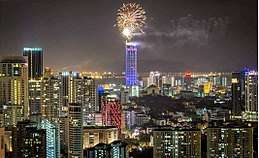
.jpg)
Ambang Tahun Baru, a celebration sponsored by the government was held at Merdeka Square, the field opposite the Sultan Abdul Samad Building in the Malaysian capital of Kuala Lumpur in the early days. The event was broadcast live on government as well as private TV stations at those times. Fireworks are displayed at the Petronas Towers.
There are New Year countdown parties in major cities such as George Town, Shah Alam and Kuching, typically organised by the private sector in these cities.[47][48]
Mongolia
Mongolians began celebrating the Gregorian New Year in the Socialist period, with influence from the former Soviet Union. As a modern tradition, New Year's Eve as well as New Year's Day are public holidays, and are two of the biggest holidays of the year. They celebrate New Year's Eve with their family. It is common, just like in the former Soviet Union, that the National Anthem of Mongolia is to be played at the midnight hour on television.
Pakistan
New Year's Eve is usually celebrated with fireworks in big cities (e.g. Lahore, Karachi and Islamabad). Musical nights and concerts are also held.
Many Pakistani youngsters enjoy the type of celebrations held the world over. The elite and educated classes participate in night-long activities in urban and cosmopolitan cities like Karachi, Lahore, and the capital of Islamabad.
Philippines
In the Philippines, New Year's Eve (Bisperas ng Bagong Taon) is a special non-working holiday. Filipinos usually celebrate New Year's Eve in the company of family or close friends. Traditionally, most households host or attend a midnight feast called the Media Noche. Typical dishes included holiday fare, pancit (for long life) and hamón. Lechon (roasted pig), is usually prepared, as is barbecued food. Some refrain from serving chicken, as their scratching and pecking for food is unlucky, being an idiom for a hand-to-mouth existence.
Many opt to wear new, bright, or colourful clothes with circular patterns, such as polka dots, or display sweets and twelve round fruits as the centrepiece, in the belief that circles attract money and fortune and that candies represent a sweeter year ahead. Several customs must only be done at midnight: some throw about coins to increase wealth in the coming year, or jump to increase their height, while some follow the Spanish custom of eating twelve grapes, one for each month of the year. People also make loud noises by blowing on cardboard or plastic horns, called torotot, banging on pots and pans, playing loud music, blowing car horns, or by igniting firecrackers, in the belief that the din scares away bad luck and evil spirits. Bamboo cannons are also fired on the night in some places.
Urban areas usually host many New Year's Eve parties and countdown celebrations hosted by the private sector with the help of the local government. These parties, which include balls hosted by hotels, usually display their own fireworks and are often very well-attended. Some popular locations for celebrations include the area along Manila Bay at Roxas Boulevard or Luneta Park in Manila, the intersection of Ayala and Makati Avenues in Makati City, Resorts World Manila and SM Mall of Asia in Pasay City, Quezon Memorial Circle in Diliman and Eastwood City in Libis, Quezon City, Bonifacio Global City in Taguig City, Entertainment City in Parañaque City, and the Philippine Arena at Ciudad de Victoria in Bocaue and Santa Maria, Bulacan.
Singapore
.jpg)
The biggest New Year's Eve celebration in Singapore takes place in the Marina Bay area. It is attended by 250,000 or more people. The party spans around the bay area starting from the Marina Bay floating Stadium to the Esplanade promenade, the Esplanade Bridge, Benjamin Sheares Bridge, Merlion Park, and the Padang at City Hall facing the Marina Bay. The celebrations are also visible from nearby hotels such as The Fullerton Hotel, Marina Mandarin, The Ritz-Carlton Millenia, Marina Bay Sands, offices located at Raffles Place, Marina Bay Financial Centre, Residential Apartments at The Sail @ Marina Bay, and from The Singapore Flyer. On the waterfront of Marina Bay, 20,000 inflatable "wishing spheres" carrying 500,000 wishes written by Singaporeans form a visual arts display filled with brilliant colors beamed from the spotlights erected along the Esplanade promenade open area. Audiences are also entertained by a host of variety shows and concerts staged at the Marina Bay floating platform stage, featuring local and overseas artists. The shows are viewable by all at the bay and telecast live on various television channels in Republic of Singapore, as well as internationally all over Southeast Asia through Channel News Asia.
At one minute to midnight, the concert emcees initiate the final countdown together with the audience. When midnight arrives, fireworks are launched from the waters at Marina Bay, lighting up the whole bay against the backdrop of the Singapore skyline.
There are other countdown parties across Singapore; these include VivoCity and areas such as -
- Ang Mo Kio
- Bedok
- Boon Lay
- Bukit Panjang
- Jurong East
- Punggol
- Sengkang
- Serangoon Gardens
- Tampines
- Woodlands
- Yishun
Taiwan

The most prominent New Year's event in Taiwan is a major fireworks show launched from the Taipei 101 skyscraper in Taipei. In 2018, the show was enhanced by the installation of a new LED display system on the north face of the tower between its 35th and 90th floors, which can be used to display digital animation effects. This change countered a reduction in the number of firework shells launched during the show, as part of an effort to produce less pollution.[50][51]
Thailand
Aside from the traditional Thai New Year called Songkran (Thailand) (which falls on 13 April or 14 April), Thais also celebrate the arrival of the Gregorian New Year on 1 January with their families, relatives and friends, which includes a family dinner and following different customs. It is a public holiday. In most cities and urban areas across Thailand, New Year's Eve celebrations are accompanied by countdowns, fireworks, concerts and other major events, notably, the CentralWorld Square at CentralWorld and the area along Chao Phraya River in Bangkok, and the Pattaya Beach in Pattaya, while public places such as hotels, pubs, restaurants and nightclubs, also host New Year's Eve parties by offering food, entertainment and music to the guests, and they usually stay open until the next morning.
Europe
Albania
Preparations for New Year's Eve in Albania start with the Christmas tree, which in Albania is known as "New Year's Tree" or "New Year's Pine". At midnight, everyone toasts and greets each other and fireworks are lit.
Austria
In Austria, New Year's Eve is usually celebrated with friends and family. At exactly midnight, all radio and television programmes operated by ORF broadcast the sound of the Pummerin, the bell of St. Stephen's Cathedral in Vienna, followed by the Donauwalzer ("The Blue Danube") by Johann Strauss II. Many people dance to this at parties or in the street. Large crowds gather in the streets of Vienna, where the municipal government organises a series of stages where bands and orchestras play. Fireworks are set off by both municipal governments and individuals.
Belgium
In Belgium, New Year's Eve (Sint Sylvester Vooravond ("Saint Sylvester's Eve") or Oudjaar ("old year")) is celebrated with family parties, called réveillons in the French speaking areas. On television, a stand-up comedian reviews the past year after which a musical or variety show signals midnight, when everyone kisses, exchanges good luck greetings, and toasts the New Year and absent relatives and friends with champagne. Many people light fireworks or go into the street to watch them. Most cities have their own fireworks display: the most famous is at Mont des Arts in Brussels. Cities, cafés and restaurants are crowded. Free bus services and special New Year's Eve taxis (the Responsible Young Drivers) bring everyone home afterwards.
On 1 January (Nieuwjaarsdag in Dutch) children read their "New Year's letter" and give holiday greeting cards of decorated paper featuring golden cherubs and angels, colored roses and ribbon-tied garlands to parents and godparents, on decorated paper.
Belgian farmers also wish their animals a happy New Year.[52]
Bosnia and Herzegovina
New Year is widely celebrated in Bosnia and Herzegovina. Streets are decorated for New Year's Eve and there is a fireworks show and concerts in all the larger cities. Restaurants, clubs, cafes and hotels are usually full of guests and they organize New Year's Eve parties.
In Sarajevo, people gather in the Square of children of Sarajevo where a local rock band entertains them. Several trumpet and rock groups play until the early morning hours. At midnight there is a big fireworks show.
Czech Republic and Slovakia
New Year's Eve (Silvestr/Silvester) celebrations and traditions in Czech Republic and Slovakia are very similar. New Year's Eve is the noisiest day of the year. People generally gather with friends at parties, in pubs, clubs, in the streets, or city squares to eat, drink, and celebrate the new year. Fireworks are a popular tradition; in large cities such as Bratislava, or Prague, the fireworks start before noon and steadily increase until midnight. In the first minutes after midnight, people toast with champagne, wish each other a happy new year, fortune and health, and go outside for the fireworks.
In both countries all major TV stations air entertainment shows before and after the midnight countdown, which is followed by the National anthem of each country. The Presidents of the republics gave their New Year speech in the morning - the new Czech President Miloš Zeman renewed the tradition of Christmas speeches. In recent years however the Czechoslovak national anthem is played at midnight, in honor of the shared history of both nations.
Denmark

People in Denmark may go to parties or entertain guests at home. There is a special evening meal that concludes with Kransekage, a special dessert, along with champagne. Other traditional dishes are boiled cod, stewed kale and cured saddle of pork.[53] However, expensive cuts of beef as well as sushi have become increasingly popular.[54]
Two significant traditional events are broadcast on television and radio on 31 December: the monarch's New Year message from Amalienborg Palace[55] at 6pm and the Town Hall Clock in Copenhagen striking midnight. Thousands of people gather together in Rådhuspladsen (the Town Hall Square) and cheer.[56] The Royal Guard[57][58] parade in their red gala uniforms. The climax of the celebration is fireworks launched as the Town Hall Tower bells chime on the stroke of midnight .After the midnight, all radio & television stations plays: "Vær Velkommen Herrens År" [Danish new year's anthem], "Kong Kristian" [Danish Royal Anthem], "Det er et Yndigt Land" [Danish National Anthem].[59]
Estonia
To celebrate New Year's Eve in Estonia, people decorate villages, visit friends and prepare lavish meals.
Some believe that people should eat seven, nine, or twelve times on New Year's Eve. These are lucky numbers in Estonia; it is believed that for each meal consumed, the person gains the strength of that many men the following year. Meals should not be completely finished—some food should be left for ancestors and spirits who visit the house on New Year's Eve.
Traditional New Year food includes pork with sauerkraut or Estonian sauerkraut (mulgikapsad), baked potatoes and swedes with hog's head, and white and blood sausage. Vegetarians can eat potato salad with navy beet and pâté. Gingerbread and marzipan are very popular for dessert. Traditional New Year drinks include beer and mead, but mulled wine and champagne have become modern favourites.
Finland
In Finland, New Year's Eve is usually celebrated with family or friends. Late supper is served, often featuring wieners, Janssons frestelse, and potato salad. Some municipalities organize fireworks at midnight. Consumer fireworks are also very popular. A Finnish tradition is molybdomancy - to tell the fortunes of the New Year by melting "tin" (actually lead) in a tiny pan on the stove and throwing it quickly in a bucket of cold water. The resulting blob of metal is analyzed, for example by interpreting shadows it casts by candlelight. These predictions are however never taken seriously.
The Finnish Broadcasting Company broadcasts the reception of the New Year at Helsinki Senate Square. Countdown to New Year is with the Helsinki Cathedral clock. In the afternoon programme, the German comedy sketch Dinner for One is shown every year. On the radio, just before midnight, the poem Hymyilevä Apollo (Smiling Apollo) by Eino Leino is read.[60]
France
In France, New Year's Eve (la Saint-Sylvestre) is usually celebrated with a feast, le Réveillon de la Saint-Sylvestre[61] (Cap d'Any in Northern Catalonia). This feast customarily includes special dishes including foie gras, seafood such as oysters, and champagne. The celebration can be a simple, intimate dinner with friends and family or, une soirée dansante, a much fancier ball.
On New Year's Day (le Jour de l'An) friends and family exchange New Year's resolutions, kisses, and wishes. Some people eat ice cream.[62]
The holiday period ends on 6 January with the celebration of Epiphany (Jour des Rois). A traditional type of flat pastry cake, la galette des rois, made of two sheets of puff pastry, filled with frangipane (almond paste) is eaten. The cake contains a fève, a small china doll; whomever finds it becomes king or queen and gets to wear a gold paper crown and choose his or her partner. This tradition can last up to two weeks.
Germany
In Germany, parties are common on New Year's Eve. Fireworks are very popular, both with individuals and at large municipal displays. 31 December and the three days leading up to it are the only four days of the year on which fireworks may be sold in Germany. Every year Berlin hosts one of the largest New Year's Eve celebrations in all of Europe, attended by over a million people. The focal point is the Brandenburg Gate, where midnight fireworks are centered. Germans toast the New Year with a glass of Sekt (German sparkling wine) or champagne. Molybdomancy (Bleigießen) is another German New Year's Eve tradition, which involves telling fortunes by the shapes made by molten lead dropped into cold water. Other auspicious actions are to touch a chimney sweep or rub some ash on your forehead for good luck and health. Jam-filled doughnuts with and without liquor fillings are eaten. Finally a tiny marzipan pig is consumed for more good luck. In some northern regions of Germany (e.g. East Frisia) the making of Speckdicken is another tradition - people go door to door visiting their neighbors and partaking in this dish. It looks similar to a pancake, but the recipe calls for either dark molasses or dark syrup, with summer sausage and bacon in the center.
Another notable tradition is the British comedy sketch Dinner for One, which has traditionally been broadcast on German television on New Year's Eve since 1972. The version traditionally broadcast on German television was originally recorded in 1963, and was occasionally used as filler programming by NDR due to popular demand; in 1972, Dinner for One received its traditional New Year's Eve scheduling. The sketch, as well as its catchphrase "the same procedure as every year", are well known in German pop culture. Dinner for One is also broadcast on or around New Year's Eve in other European countries, although it is, ironically, relatively unknown in the United Kingdom.[63][46]
Greece
New Year's Eve in Greece has many traditions. During the day, children sing the New Year's carols to be given money or treats. Then, it is time to have family lunch or dinner. In the evening, people cook a pie named "King's pie (Vassilopita locally)", which is a cake flavored with almonds. Following tradition, they put a coin wrapped in aluminium foil inside the pie.
During the family dinner, the hostess puts some of her jewelry in a plate and serves it in the side of the table, as a symbol of the coming year's prosperity. After the dinner is over, the dishes are not washed until the next day. The reason for that is that Saint Vassilis (Greek Santa Claus) is awaited during the New Year's Eve and it is considered common courtesy to leave some food for the traveler who visits the house to bring the presents during the night.
When midnight arrives, the families count down and then they turn off all the lights and reopen their eyes to "enter the year with a new light". After the fireworks show, they cut the "Vassilopita" and serve it. The person that gets the wrapped coin is the lucky person of the day and he is also blessed for the rest of the year. Gifts exchanges may follow.
Hungary

New Year's Eve (Szilveszter) in Hungary is celebrated with home parties and street parties, including a gathering in downtown Budapest. Fireworks and firecrackers are popular. Champagne, wine and traditional Hungarian New Year dishes—frankfurter sausages with horseradish, lentil soup, fish, and roast pig—are consumed. The national anthem is commonly sung at midnight.
In past centuries, some Hungarians believed that animals were able to speak on New Year's Eve, and that onion skins sprinkled with salt could indicate a rainy month.
Hungarian Christian communities focus on celebrating Mass on both New Year's Eve and New Year's Day.[64][65]
Iceland
Fireworks are very popular in Iceland, particularly on New Year's Eve. Iceland's biggest New Year's Eve events are usually in and around the capital, Reykjavík.
Áramótaskaupið ("The New Year's comedy") is an annual Icelandic television comedy special, which is an important part of the New Year for most. It focuses satirically on the past year, and shows little mercy for its victims, especially politicians, artists, prominent business people and activists.
Ireland
New Year's Eve (Oíche Chinn Bliana, Oíche na Coda Móire, or Oíche Chaille) celebrations in major cities are modest, with most people favouring small parties in the home for family and friends.
Italy
In Italy, New Year's Eve (Vigilia di Capodanno or Notte di San Silvestro) is celebrated by the observation of traditional rituals, such as wearing red underwear. An ancient tradition in southern regions which is rarely followed today was disposing of old or unused items by dropping them from the window.
Dinner is traditionally eaten with relatives and friends. It often includes zampone or cotechino (a meal made with pig's trotters or entrails), and lentils. At 20:30, the President reads a television message of greetings to Italians.
At midnight, fireworks are displayed all across the country. Rarely followed today is the tradition that consist in eating lentil stew when bell tolls midnight, one spoonful per bell. This is supposed to bring good fortune; the round lentils represent coins.
Macedonia
New Year's Eve is celebrated across Macedonia. New Year's Day is celebrated by day-long fireworks shows. The day is celebrated together with family or friends at home or in restaurants, clubs, cafés and hotels. During the day-time celebration, children get gifts. Evening celebrations include food, music, and dancing to both traditional Macedonian folk music, and modern music. New Year's Eve is celebrated on 31 December and also on 14 January according to the Macedonian Orthodox Calendar.
Malta
Malta organized its first New Year's street party in 2009 in Floriana. The event was not highly advertised and proved controversial, due to the closing of an arterial street for the day. In 2010 there were the first national celebrations in St. George's Square, Valletta[66] Although professional fireworks are very popular in Malta, they are almost totally absent on New Year's Eve. Usually the Maltese hit nightclubs and specific dance music parties to celebrate New Year's Eve.
Montenegro
In Montenegro, New Year's Eve celebrations are held in all large cities, usually accompanied by fireworks. It is usually celebrated with family or friends, at home or outside. Restaurants, clubs, cafés and hotels organize celebrations with food and music.
Netherlands
New Year's Eve (Oud en Nieuw or Oudejaarsavond) in the Netherlands is usually celebrated as a cozy evening with family or friends, although many people attend big organized parties. Traditional snack foods are oliebollen (oil dumplings) and appelbeignets (apple slice fritters).[67] On television, the main feature is the oudejaarsconference, a performance by one of the major Dutch cabaretiers (comparable to stand-up comedy, but more serious, generally including a satirical review of the year's politics). Historically, in Reformed Protestant families, Psalm 90 is read, although this tradition is now fading away.[68] At midnight, Glühwein (bishops wine) or champagne is drunk. Many people light their own fireworks. Towns do not organize a central fireworks display, except for Rotterdam where the national fireworks display can be seen near the Erasmus Bridge.
Norway
In Norway New Year's Eve (Nyttårsaften) is the second biggest celebration of the year, after Christmas Eve. While Christmas Eve is a family celebration, New Year's Eve is an opportunity to celebrate with friends.
Traditionally, there is first a feast, commonly consisting of stuffed, roast turkey with potatoes, sprouts, gravy and Waldorf salad. The accompanying beverage is traditionally beer (commonly either Christmas beer or lager beer). Dessert will often be vanilla pudding or rice cream, and there will be cakes and coffee later in the evening - commonly accompanied by a glass of cognac. Then, at close to 12 am on New Year's Day, people will go outside to send up fireworks. Fireworks are only permitted to be sold to the general public on the days leading up to New Year's Eve, and only to be launched that night.
Due to the general use of fireworks, more fires occur on New Year's Eve than on any other day of the year in Norway. Accordingly, most Norwegian cities, and many towns, host a large, public fireworks display in order to discourage private use of fireworks in built-up areas. People will then congregate in a central square or similar to watch and celebrate.
Poland
In Poland New Year's Eve (Sylwester) celebrations include both indoor and outdoor festivities. A large open-air concert is held in the Main Square in Kraków. 150,000 to 200,000 revelers celebrate the New Year with live music and a fireworks display over St. Mary's Basilica.[69] Similar festivities are held in other cities around Poland.
For those who do not wish to spend the New Year in the city, the mountains are a popular destination. Zakopane, located in the Carpathian Mountains, is the most popular Polish mountain resort in winter.
Also, New Year's Eve (Sylwester) celebrations are in Katowice, near the Spodek arena. In Sławatycze, people tour the streets dressed up as bearded men.[42]
Portugal
In Portugal the New Year celebration is taken very seriously. The tradition is to drink champagne and eat twelve raisins - one for each month of the year, making a wish for each. Another Portuguese tradition is a special cake called Bolo-Rei (literally: King Cake). Bolo-Rei is a round cake with a large hole in the centre, resembling a crown covered with crystallised and dried fruit. It is baked from a soft, white dough, with raisins, various nuts and crystallised fruit. Inside is hidden the characteristic fava (broad bean). Tradition dictates that whoever finds the fava has to pay for the Bolo-Rei next year. Initially, a small prize (usually a small metal toy) was also included within the cake. However, the inclusion of the prize was forbidden by the European Union for safety reasons. The Portuguese brought the recipe of the Gateau des Rois from France in the second half of the 19th century. To this day, this recipe is a very well kept secret.
In Lisbon the New Year is celebrated with a grand concert. The New Year's Concert is held at the CCB (Centro Cultural de Belém) on the evening of 1 January, featuring the prestigious Lisbon Metropolitan Orchestra.
Romania
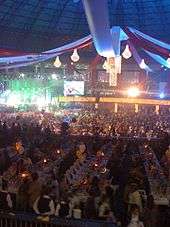
Traditional celebrations of New Year's Eve (Revelion) are the norm in Romania. Romanians follow centuries-old customs, rituals, and conventions. Children sing "Plugușorul" and "Sorcova", traditional carols that wish goodwill, happiness and success.
Parties are common in the evening. Since the Romanian Revolution of 1989, Romanians have gathered in the University Square in Bucharest. Other significant parties occur in Piața Constituției. New Year's Eve is also marked by a national all-night telecast on Romanian Television, which also celebrates its anniversary on this holiday, having opened its doors in the New Year's Eve of 1956.
Russia
Most Russians celebrate New Year's Eve with their families and close friends. The origin of this holiday in Russia derives from Christmas. Christmas was also a major holiday in Russia until it was banned, with all other religious holidays, by the Communist Party. To compensate for the absence of Christmas, New Year's was celebrated as much as Christmas was, but without the religious aspect of the holiday and lot of a Christmas attributes were repurposed, such as Christmas tree, which became a New Year tree. Even after the fall of the Soviet Union, New Year's is still celebrated in Russia and has become a Russian tradition. There is an old superstition that if the first visitor (especially an unexpected one) on 1 January is a male, the year will be good. People also try to start the new year without debts.
The celebration usually starts one or two hours before midnight. A common tradition is to "say farewell to the old year" by remembering the most important events of the last twelve months. At five minutes to midnight most people watch the president's New Year speech on TV[70] and watch popular films or New Year TV shows before and after midnight. There is a tradition to listen to the Kremlin clock bell ringing twelve times on the radio or on TV, which is followed by the national anthem.[71][72] During these twelve seconds people keep silence and make their secret wishes for the next year. After the clock strikes, they drink champagne and have rich dinner, watching TV concerts and having fun. Some people light fireworks outside and visit their friends and neighbors. As 30 and 31 December are working days, a lot of people also have parties at work (so-called "corporatives"), though 31 December is mostly spent at home or with friends. Grandfather Frost and his granddaughter Snowmaiden bring presents on New Year's Eve.
On 13 January, some of people celebrates "Old New Year", according to the Julian calendar.
Serbia
New Year's Eve in Serbia is traditionally celebrated extensively. Indoors, families celebrate New Year's Eve with an abundance of food. Serbs decorate trees, Novogodišnja jelka, at New Year's Eve, rather than at Christmas Eve. Near, or after midnight, Santa Claus (Deda Mraz) visits houses and leaves presents under the tree, to be unpacked then or, if the family is asleep, to be discovered in the morning.
Serbian New Year's celebrations take place in Belgrade, and several other major cities such as Novi Sad and Niš. As of mid-December, cities are extensively decorated and lit. The decorations remain until way into January due to the influence of the Julian calendar. Throughout the region, especially amongst former Yugoslav republics, Belgrade is the most popular destination for major parties.
On 13 January, a large part of the population celebrates "Serbian New Year", according to the Julian calendar. Usually one concert is organized in front of either City Hall or the National Parliament in Belgrade, while fireworks are prepared by the Serbian Orthodox Church and fired from the Cathedral of Saint Sava, where people also gather. Other cities also organize such celebrations.
Slovenia
In Slovenia, New Year's Eve is known as a Saint Sylvester's Day (Silvestrovo). Streets are decorated for the whole December. In larger cities like Ljubljana, Maribor, Celje or Koper there are concerts, culture programm and countdown followed by fireworks. There is also special programme on the national TV. Tradition is, that family comes together and have a dinner. At midnight, people toast with champagne, wish each other a happy new year, fortune and health. People have already decorated the Christmas tree before Christmas and children are waiting for the third "Good man of December - Dedek Mraz."
Spain

Spanish New Year's Eve (Nochevieja or Fin de Año) celebrations usually begin with a family dinner, traditionally including shrimp or prawns, and lamb or capon. The actual countdown is primarily followed from the clock on top of the Casa de Correos building in Puerta del Sol Square in Madrid. It is traditional to eat Twelve Grapes, one on each chime of the clock. This tradition has its origins in 1909, when grape growers in Alicante thought of it as a way to cut down on the large production surplus they had had that year. Nowadays, the tradition is followed by almost every Spaniard, and the twelve grapes have become synonymous with the New Year. After the clock has finished striking twelve, people greet each other and toast with sparkling wine such as cava or champagne, or with cider. The song "Un año más," by the Spanish group Mecano, is frequently played.
Earlier in the evening at around 20:00, there is a 10k run called San Silvestre Vallecana, which starts on Paseo de la Castellana, next to Santiago Bernabéu Stadium, and ends at the Vallecas Stadium. Professional runners come to Madrid for this 10k.
After the family dinner and the grapes, many young people attend cotillones de nochevieja parties (named for the Spanish word cotillón, which refers to party supplies like confetti, party blowers, and party hats) at pubs, clubs, and similar places. Parties usually last until the next morning and range from small, personal celebrations at local bars to huge parties with guests numbering the thousands at hotel convention rooms. Early the next morning, party attendees usually gather to have the traditional winter breakfast of hot chocolate and fried pastry (chocolate con churros).
Sweden
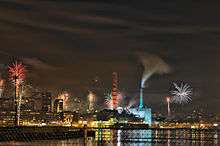
In Sweden, New Year's Eve is usually celebrated with families or with friends. A few hours before and after midnight, people usually party and eat a special dinner, often three courses. New Year's Eve is celebrated with large fireworks displays throughout the country, especially in the cities. People over the age of 18 are allowed to buy fireworks, which are sold by local stores or by private persons. While watching or lighting fireworks at midnight, people usually drink champagne.
Switzerland
In Switzerland, New Year's Eve is typically celebrated at a residence with friends. There are no particular main dishes associated with the event, although sweets and desserts are usual. Each commune has its own government-arranged countdown in a public space, accompanied with formal fireworks shows in smaller cities.
Ukraine
In the countries that were formerly part of the Soviet Union, New Year's has the same cultural significance as Christmas has in the United States, but without the religious connotations. Ukrainian families traditionally install spruce trees at home, the equivalent of a Christmas tree. Families gather to eat a large feast and reflect on the past year. They have a large celebration, make toasts, and make wishes for a happy New Year. Families give presents to their friends as well as informal acquaintances. As Ukrainians are traditionally a closely knit community, it is seen as a taboo to not give presents to those the family associates with. Children stay up until midnight, waiting for the New Year. During these celebrations many Ukrainians tune to special New Year shows, which have become a long-standing tradition for the Ukrainian TV. And just before midnight the President of Ukraine gives his New Year's message to the nation, and when the clock strikes 12, the National Anthem Shche ne vmerla Ukraina is played in all TV and radio stations as well as in Independence Square in Kiev and other cities where holiday celebrations are held.
The first New year dish in Ukraine which associates with the New year for every Ukrainian person is the Olivier salad. It has become the main «character» of many jokes and anecdotes. There are several versions about where the name Olivier comes from, but most people say that it appeared thanks to the French chef Olivier, who lived in the USSR in the 1960s and was the owner of a French restaurant in Moscow. He was the first one to cook this dish. Nowadays this salad is also called Russian, potato and meat salad.[73]
New Year is often considered a "pre-celebration" for Greek Catholics and Eastern Orthodox living in Eastern Europe, primarily in Ukraine, since Christmas is celebrated on 7 January.
United Kingdom
England

The most prominent New Year's celebration in England is that of Central London, where the arrival of midnight is greeted with the chimes of Big Ben. In recent years, a major fireworks display has also been held, with fireworks launched from the nearby London Eye Ferris wheel. On New Year's Eve 2010, an estimated 250,000 people gathered to view an eight-minute fireworks display around and above the London Eye which was, for the first time, set to a musical soundtrack.[74] The celebrations in London continued into 1 January, with the New Year's Day Parade, held annually since 1987. The 2011 parade involved more than 10,000 musicians, cheerleaders and performers.[75]
Other major New Year events are held in the cities of Birmingham, Manchester, Liverpool, Leeds, and Newcastle.
Scotland
In Scotland, New Year's (Hogmanay) is celebrated with several different customs, such as First-Footing, which involves friends or family members going to each other's houses with a gift of whisky and sometimes a lump of coal.
Edinburgh, the Scottish capital, hosts one of the world's most famous New Year celebrations. The celebration is focused on a major street party along Princes Street. The cannon is fired at Edinburgh Castle at the stroke of midnight, followed by a large fireworks display. Edinburgh hosts a festival of four or five days, beginning on 28 December, and lasting until New Year's Day or 2 January, which is also a bank holiday in Scotland.
Other cities across Scotland, such as Aberdeen, Glasgow and Stirling have large organised celebrations too, including fireworks at midnight.
BBC Scotland broadcast the celebrations in Edinburgh to a Scottish audience, with the celebrations also screened across the world. STV covers both worldwide New Year celebrations, and details of events happening around Scotland.
Wales
The Welsh tradition of giving gifts and money on New Year's Day (Welsh: Calennig) is an ancient custom that survives in modern-day Wales, though nowadays it is now customary to give bread and cheese.[76]
Thousands of people descend every year on Cardiff to enjoy live music, catering, ice-skating, funfairs and fireworks. Many of the celebrations take place at Cardiff Castle and Cardiff City Hall.
Every New Year's Eve, the Nos Galan road race (Rasys Nos Galan), a 5-kilometre (3.1 mi) running race, is held in Mountain Ash in the Cynon Valley, Rhondda Cynon Taf, South Wales. The race celebrates the life and achievements of Welsh runner Guto Nyth Brân.
Founded in 1958 by local runner Bernard Baldwin, it is run over the 5 kilometre route of Guto's first competitive race. The main race starts with a church service at Llanwynno, and then a wreath is laid on Guto's grave in Llanwynno graveyard. After lighting a torch, it is carried to the nearby town of Mountain Ash, where the main race takes place.
The race consists of a double circuit of the town centre, starting in Henry Street and ending in Oxford Street, by the commemorative statue of Guto. Traditionally, the race was timed to end at midnight, but in recent times it was rescheduled for the convenience of family entertainment, now concluding at around 9pm.
This has resulted in a growth in size and scale, and the proceedings now start with an afternoon of street entertainment, and fun run races for children, concluding with the church service, elite runners' race and presentations.
Middle East
Israel
New Year's Eve (Sylvester) in Israel, is celebrated by parties, social get togethers, concerts, and dining out in major cities such as Jerusalem and Tel Aviv. Immigrants from the former USSR celebrate Novy God, the Russian version of the holiday.
Lebanon and Syria
In Lebanon and Syria, people celebrate New Year's Eve with a dinner attended by family and friends. The dinner features traditional dishes such as tabouli, hummus, kibbi, and other Lebanese foods. These celebrations could also take place in restaurants and clubs. Game shows are also organized where people can try to win money. The countdown to New Year's is broadcast through the leading TV channel and the celebrations usually continue until sunrise. Fireworks are lit throughout the night.
Saudi Arabia
In Saudi Arabia, New Year's is solely celebrated in private gatherings. As the Islamic calendar is the official civic calendar, the Committee for the Promotion of Virtue and the Prevention of Vice—Saudi Arabia's religious police, has enforced a ban on public festivities of the Gregorian New Year. The organization can also fine shops for offering New Year's-related products, and confiscate them. However, the organization does not go after individual citizens holding private celebrations.[77][78]
United Arab Emirates
In Dubai, United Arab Emirates, New Year's fireworks are set off from Jumeirah Beach (including Burj Al Arab) and the world's tallest building, Burj Khalifa. The New Year fireworks display at Burj Khalifa is among the world's most expensive.
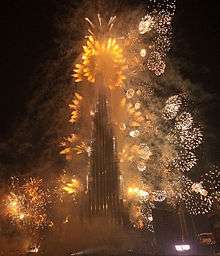
Turkey
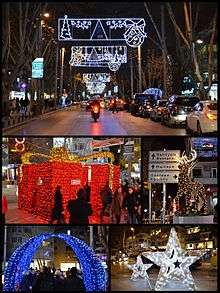
Numerous decorations and customs traditionally associated with Christmas and Bayrams are part of secular New Year's Eve celebrations in Turkey. Homes and streets are lit in glittering lights. Small gifts are exchanged, and large family dinners are organized with family and friends, featuring a special turkey dish stuffed with a zante currant, pine nuts, pimiento and dill iç pilav, dolma, hot börek, baklava, and various other Turkish dishes, accompanied with rakı, Turkish wine, or boza, şerbet, salep, and Turkish tea or coffee. Even though Turkish people generally do not celebrate Christmas, decorating Christmas trees is a very popular tradition on New Year's Eve in Turkey, and the Turks associate Santa Claus with New Year's Eve.
Television and radio channels are known to continuously broadcast a variety of special New Year's Eve programs, while municipalities all around the country organize fundraising events for the poor, in addition to celebratory public shows such as concerts and family-friendly events, as well as more traditional forms of entertainment such as the Karagöz and Hacivat shadow-theater, and even performances by the Mehter—the Janissary Band that was founded during the days of the Ottoman Empire.
Public and private parties with large public attendances are organised in a number of cities and towns, particularly in the largest metropolitan areas such as Istanbul, Ankara, Izmir, Adana, Bursa and Antalya, with the biggest celebrations taking place in Istanbul's Taksim, Beyoğlu, Nişantaşı and Kadıköy districts and Ankara's Kızılay Square, which generally feature dancing, concerts, laser and lightshows as well as the traditional countdown and fireworks display.
Oceania
Australia
Each major city in Australia holds New Year's Eve celebrations, usually accompanied by a fireworks display and other events. Gloucester Park, a racecourse in central Perth, is the largest and most recognized display in the Western Australian city. In Brisbane events are held at Southbank. At night, 50,000 people gather at sites around the Brisbane River to watch a fireworks display.
The largest celebration in Australia is held in its largest city: Sydney. Each year, the celebrations in Sydney are accompanied by a theme with two pyrotechnic shows: the 9:00 pm Family Fireworks and the Midnight Fireworks. Centering on the Sydney Harbour Bridge, the fireworks are synchronized to a blend of popular music and a lighting display called the "Bridge Effect", which displays various symbols and other images related to the current year's theme, located on the bridge itself. The "Midnight Fireworks" are regularly watched by approximately 1.5–2 million people at Sydney Harbour. As one of the first major New Year's celebrations globally each year, Sydney's Midnight Fireworks are often broadcast throughout the world during the day of 31 December. In Melbourne, the city follows suit with Sydney having a 9:30 Family Fireworks followed by the midnight fireworks. Celebrations are mostly centered on the Yarra River and Federation Square, as well as Docklands. Most of the firework shows in Melbourne are launched from boats along the river and from atop the city's various skyscrapers.
Kiribati
Kiritimati (UTC+14), part of Kiribati, is one of the first locations in the world to welcome the New Year. Other Kiribati islands follow at UTC+13 and UTC+12.
New Zealand
Many of New Zealand's cities and towns see in the new year with open-air concerts and fireworks displays.
Auckland regularly has a fireworks display at midnight from the top of the Sky Tower. In Wellington, Frank Kitts Park is the venue for a festival including fireworks, music, and open-air film displays. Similar events occur in Hamilton, starting with a family-friendly event at Steele Park, followed by an adult-specific party at SkyCity Hamilton. Gisborne, one of the first cities in the world to see sunrise at new year[79] also celebrates with a new year festival. The small town of Whangamata, on the Coromandel Peninsula, is a major party venue at new year, especially for Aucklanders.
In the South Island, both Christchurch and Dunedin host free live music concerts culminating with a midnight fireworks display. These are held at Hagley Park and The Octagon respectively. The South Island's main resort town, Queenstown is also a major new year party venue, with music and fireworks.
Samoa
Since changing the time zone from UTC-11 to UTC+13 in winter and UTC+14 in summer (including new year), Samoa is the first country to receive the New Year as a whole, sharing it with some parts of Kiribati.
Music
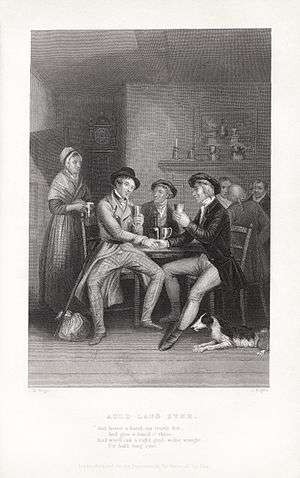
Music associated with New Year's Eve comes in both classical and popular genres, and there is also Christmas song focus on the arrival of a new year during the Christmas and holiday season.
- Auld Lang Syne by Robert Burns.[80]
- Johann Sebastian Bach, in the Orgelbüchlein, composed three chorale preludes for the new year: Helft mir Gotts Güte preisen ["Help me to praise God's goodness"] (BWV 613); Das alte Jahr vergangen ist ["The old year has passed"] (BWV 614); and In dir ist freude ["In you is joy"] (BWV 615).[81]
- The year is gone, beyond recall is a traditional Christian hymn to give thanks for the new year, dating back to 1713.[82]
- Happy New Year by ABBA.
- Imagine by John Lennon.
- It Was a Very Good Year by Frank Sinatra.
- It's Just Another New Year's Eve by Barry Manilow.
- Let's Start the New Year Right by Bing Crosby.
- New Year's Day by U2.
- Same Old Lang Syne by Dan Fogelberg.
- Let's Spend This New Year's Eve At Home by Christi Bauerlee.
- Kiss Me at Midnight by 'N Sync from their 1998 album The Winter Album.
- This Is the New Year by A Great Big World.
- New Year's Day by Taylor Swift.
- 1999 by Prince's
- Will 2K by Will Smith
- Millennium by Robbie Williams
- Disco 2000 by Pulp
- Año Más by Mecano
See also
|
|
References
- ↑ Emily Allen (31 December 2016). "New Year's Eve: When is it 2017 around the world?". The Telegraph. Retrieved 31 December 2016.
- ↑ "Christmas & New Year's Eve Food in Argentina". Asado Argentina. 15 December 2008. Retrieved 31 December 2010.
- ↑ "Éxodo por Año Nuevo". InfoRegión. 29 December 2010. Retrieved 17 January 2011.
- ↑ "Prefeita anuncia atrações para o Réveillon 2010" (in Portuguese). Prefeitura Municipal de Fortaleza. 1 December 2009. Retrieved 31 December 2010.
- ↑ "Réveillon de Fortaleza: mais de um milhão de pessoas compareceram à festa" (in Portuguese). Jangadeiro Online. 1 January 2010. Retrieved 31 December 2010.
- ↑ "New Year's Eve in Brazil". Hostels Club. Retrieved 31 December 2010.
- ↑ "Réveillon 2018: Confira a festa da virada no Brasil" (in Portuguese). Terra. 1 January 2018. Retrieved 3 January 2010.
- ↑ "Réveillon pelo Brasil: 5 opções gratuitas para celebrar a chegada de 2018" (in Portuguese). HuffPost. 30 December 2017. Retrieved 3 January 2010.
- ↑ "Salvador celebra Ano Novo com mega festa e atrações de peso" (in Portuguese). Quem Acontece. 1 January 2018. Retrieved 3 January 2018.
- ↑ "Confira as festas de Réveillon no Litoral Catarinense" (in Portuguese). Diário Catarinense. 29 December 2017. Retrieved 3 January 2018.
- ↑ "Paulista Avenue on New Year's Eve: A Race and a Party". Gobrazil.about.com. 31 December 2008. Retrieved 31 December 2010.
- ↑ "New Year's Eve in Canada".
- ↑ Bill Harris (18 December 2010). "'Air Farce' returns once again". Toronto Sun. Retrieved 11 January 2011.
- ↑ Harris, Bill (18 December 2009). "Farce back for New Year's Eve". Toronto Sun. Retrieved 29 December 2009.
- ↑ Producers apologize for offensive skits in Quebec New Year's Eve special on CBC.ca, 9 January 2009.
- ↑ "Tradiciones chilenas para el año nuevo". This is Chile (in Spanish). 30 December 2016.
- ↑ "Un millón de personas disfrutó del "Año Nuevo en el Mar" en Valparaíso".
- ↑ "Ley 19680: Prohíbe el uso de fuegos artificiales, mediante reforma de la Ley Nº 17.798, sobre control de armas y explosivos, y prohíbe la venta al público de fuegos artificiales y regula la realización de espectáculos pirotécnicos masivos".
- ↑ "Guatemala: Society and Culture / Holidays and Festivals". Atozworldtravel.com. Retrieved 31 December 2010.
- ↑ "Guatemala Holidays". Destination360.com. Retrieved 31 December 2010.
- ↑ "Christmas traditions in spain and latin america". Ompersonal.com.ar. Archived from the original on 27 May 2010. Retrieved 31 December 2010.
- ↑ "TOPICS Online Magazine - ESL/EFL - Sandy Peters and Thomas Peters". Retrieved 31 December 2015.
- ↑ "Mexican customs for the New Year". Focus on Mexico. Archived from the original on 11 July 2011. Retrieved 31 December 2010.
- ↑ "New Year's Eve in Mexico - Año Nuevo Celebrations". Gomexico.about.com. 23 December 2010. Retrieved 31 December 2010.
- ↑ "NYC ball drop goes 'green' on 100th anniversary". CNN. 31 December 2007. Retrieved 2 December 2012.
- ↑ "Judge says Brasstown's 'possum drop can proceed". Citizen-Times. Gannett Company. Retrieved 11 January 2017.
- ↑ "34 Bizarre Things Being Dropped on New Year's Eve". Mental Floss. Retrieved 11 January 2017.
- ↑ Lynch, Stephen (31 December 1999). "New Year's song remains ingrained in public mind". The Orange County Register. Archived from the original on 26 April 2005.
- ↑ Moore, Frazier (26 December 2001). "Next week to be 25th New Year's Eve without Guy Lombardo". Pittsburgh Post-Gazette. Associated Press. Retrieved 1 January 2007.
- ↑ Memmott, Carol (27 December 2011). "Dick Clark: Rockin' it on New Year's since 1972". USA Today. Retrieved 2 March 2012.
- ↑ "Dick Clark, Entertainment Icon Nicknamed 'America's Oldest Teenager,' Dies at 82". ABC News. 18 April 2012. Retrieved 18 April 2012.
- ↑ Geoff Boucher (19 April 2012). "Dick Clark dies at 82; he introduced America to rock 'n' roll". Los Angeles Times. Retrieved 19 April 2012.
- ↑ Stelter, Brian (31 December 2011). "4 Decades Later, He Still Counts". The New York Times. p. C1. Retrieved 1 January 2012.
- ↑ Ng, Philiana (28 November 2012). "Ryan Seacrest's 'New Year's Rockin' Eve' Announces Lineup". The Hollywood Reporter. Retrieved 29 November 2012.
- 1 2 3 "Four Cities That Celebrate New Year's Eve in a Big Way". New York Times. Retrieved 6 November 2016.
- ↑ Saillant, Catherine; Schaefer, Samantha (1 January 2014). "Grand Park New Year's Eve bash called a success". Los Angeles Times. Retrieved 2 November 2014.
- ↑ "Chi-Town Rising promises free viewing areas this New Year's Eve". Retrieved 30 December 2016.
- ↑ "When are the busiest times at Walt Disney World?". WESH.com. Hearst Television. Retrieved 6 November 2016.
- ↑ "Disneyland reopens after temporarily closing gates to new visitors on Christmas afternoon". Orange County Register. Retrieved 6 November 2016.
- ↑ Butler, Joey (November–December 2006). "Watch Night services provide spiritual way to bring in New Year". The United Methodist Church Interpreter Magazine. Archived from the original on 1 March 2012. Retrieved 10 January 2010.
- ↑ Sutton, Charyn (August 2004). "Watch Night". Western States Black Research & Educational Center. Archived from the original on 14 June 2010. Retrieved 10 January 2010.
- 1 2 "New Year's Eve 2017: How the world celebrates today". www.aljazeera.com. Retrieved 31 December 2017.
- ↑ The Republic of Bangladesh enjoys almost 60-94 weddings every after 1 or 2 years on 31 December
- ↑ Bangladesh celebrates New Year in ships and yachts
- ↑ The Muslim Republican of Bangladesh prays to Allah for a fruitful year
- 1 2 Peake, Mike (30 December 2006). "Gesundheit to an old favourite". The Daily Telegraph. London. Retrieved 1 January 2007.
- ↑ "Ushering in 2018 in high spirits - Nation | The Star Online". www.thestar.com.my. Retrieved 1 January 2018.
- ↑ "Much to look forward to in 2018". BorneoPost Online | Borneo , Malaysia, Sarawak Daily News. 31 December 2017. Retrieved 1 January 2018.
- ↑ "New Year's Celebration in Pakistan". Daily Pakistan. 1 January 2017.
- ↑ "Xiangshan good for watching Taipei 101 fireworks display but not for light show: GEO". Taiwan News. Retrieved 2 January 2018.
- ↑ "Taipei 101 New Year's Eve fireworks display to be longest ever". Focus Taiwan. Retrieved 2 January 2018.
- ↑ Christine OKeeffe. "Belgian New Year: Sint Sylvester Vooranvond". Retrieved 31 December 2015.
- ↑ "Danish Traditions". Denmark-getaway.com. Retrieved 31 December 2010.
- ↑ (in Danish) Ekstra Bladet - Sushi hitter nytårsaften. Ekstrabladet.dk. Retrieved 17 August 2013.
- ↑ "Nytårstaler". Kongehuset.dk. 21 May 2010. Archived from the original on 26 December 2010. Retrieved 31 December 2010.
- ↑ "New Year's Eve 2010-2011 Copenhagen". Visitcopenhagen.com. Archived from the original on 13 December 2010. Retrieved 31 December 2010.
- ↑ Katrine Kielland-Brandt. "Den Kongelige Livgardes Musikkorps". Retrieved 31 December 2015.
- ↑ "Globalnavigation". Retrieved 31 December 2015.
- ↑ "Christmas - Newyear in Copenhagen and Denmark — December 2010". Copenhagenet.dk. 13 December 1944. Retrieved 31 December 2010.
- ↑ Liukkonen, Petri. "Eino Leino". Books and Writers (kirjasto.sci.fi). Finland: Kuusankoski Public Library. Archived from the original on 5 March 2007.
- ↑ "le Réveillon de la Saint-Sylvestre" .Vibescout.com. Retrieved 14 December 2017
- ↑ "New Year's Day in France".
- ↑ "The Mystery of Dinner for One". Slate. Retrieved 18 July 2017.
- ↑ Kerry Kubilius. "New Year's Eve in Budapest". About.com Travel. Archived from the original on 6 September 2015. Retrieved 31 December 2015.
- ↑ Kerry Kubilius. "New Year's Eve in Hungary". About.com Travel. Retrieved 31 December 2015.
- ↑ "Official New Year's Eve Street Celebrations Website in Malta". Maltanewyearseve.com. Archived from the original on 6 December 2010. Retrieved 31 December 2010.
- ↑ "New Year's Day in the Netherlands".
- ↑ Wim Kan displaced Psalm 90 and prayer, Trouw, 31 December 2001 (in Dutch)
- ↑ Świerczek, Marcin (2008). "Tylko w Onet.tv - sylwester z krakowskiego Rynku na żywo!". Kraków: Onet.tv from Polish Press Agency. Archived from the original on 17 January 2009. Retrieved 31 December 2010
- ↑ Talmazan, Yuliya (30 December 2009). "Top Ten Traditions No Winter Holiday Season In Russia Goes Without". Archived from the original on 26 February 2010. Retrieved 31 December 2010.
- ↑ "USSR 1990 New Year's Message Prt. 2 of 2". YouTube. Retrieved 31 July 2014.
- ↑ "Putin: New Year's Address to the Nation (English Subtitles)". YouTube. Retrieved 31 July 2014.
- ↑ "New year dish - Ukrainian food - Diolli.com". 20 December 2016.
- ↑ "London Eye fireworks mark new year 2011". BBC News. 1 January 2011.
- ↑ Batty, David (1 January 2011). "New Year's Eve in the UK: 'The best fireworks ever'". The Guardian. London.
- ↑ Hutton, Ronald (1996). The Stations of The Sun. Oxford, UK: Oxford University Press. p. 67. ISBN 0-19-820570-8.
- ↑ "Saudi warns public against New Year celebration". Emirates 24/77. Retrieved 2 December 2014.
- ↑ "Saudi 'mutawa' warn against New Year revelry". Al Jazeera. Retrieved 2 December 2014.
- ↑ Gisborne is further east than any other New Zealand city, but due to the earth's axial tilt, the hills around Dunedin also receive sunrise at an almost identical time at new year. Nuku'alofa in Tonga and Apia and Samoa also receive the sun at almost exactly the same time. Given that the earth's axial tilt oscillates fractionally, the title of "first city to see the sun" — though usually claimed by Gisborne — is open to some debate.
- ↑ "Scotland - In the words of the Bard -". Scotland.
- ↑ "Table of Contents: Orgelbüchlein :". libweb.grinnell.edu.
- ↑ "The Year Is Gone, Beyond Recall". www.hymntime.com.
External links
| Look up New Year's Eve or Happy new year in Wiktionary, the free dictionary. |
| Wikimedia Commons has media related to New Year's Eve. |
- New Year's Around the World - slideshow by Life magazine
